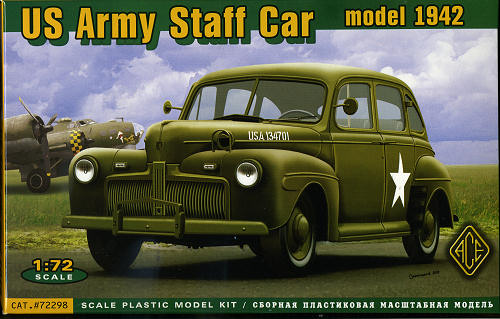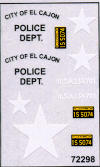
| KIT #: | 72298 |
| PRICE: | $9.95 from www.scale-model-kits.com |
| DECALS: | Two options |
| REVIEWER: | Scott Van Aken |
| NOTES: | Low pressure molding |

| HISTORY |
The Ford car was thoroughly updated in 1941, in preparation for a time of unpredictability surrounding World War II. The 1941 design would continue in an aborted 1942 model year and would be restarted in 1946 and produced until the more modern 1949 Fords were ready.
The two previous Ford car lines, standard and De Luxe, had blossomed into three, Special, De Luxe, and Super De Luxe. This time, the entry-level 136 CID (2.2 L) V8 was deleted in favor of a new 226 CID (3.7 L) L-head straight-6, the first Ford six since the failed 1906 Model K. The popular 221 CID (3.6 L) V8 remained as the top-line engine and was standard in De Luxe models. Both engines were rated at 90 hp. The 239 CID engine, introduced in 1939 for Mercury and Trucks, was continued in the Mercury Models. The chassis was longer, with a 114 in (2896 mm) wheelbase.
The "ignition key" for these cars was actually used to operate a bolt lock which, on one end, unlocked the steering column (a feature destined to return, mandated, decades later), and on the other end unblocked the ignition switch, allowing it to be operated. Starting the car was then accomplished by pressing a pushbutton on the dashboard, another feature destined to return with the advent of "smart keys."
Although starting cranks had been replaced by electric starters for decades, Ford cars included a manual starting feature until 1948 as an antidote to dead-battery syndrome. The wheel-lug wrench served as a handle (also for the jack) and the jack shaft with bayonet-coupling pins could be inserted through a small hole in the grille to engage a bayonet socket on the forward end of the engine crankshaft. A quick-and-easy twist of the handle was sufficient to start the flat head V8, and the bayonet coupling was self-disengaging for safety.
Ford halted its car and truck lines on February 10, 1942 to begin war production, but not before a short run of 1942 cars was built. Changes were made to the car besides a three-part "electric shaver" grille — the frame was lowered and softer springs were used to improve the ride. War rationing required auto makers to black out their chrome trim, and a Special Fordor model was produced with no chrome at all for military use. The pickup received new styling as well, with heavy vertical bars, and truck production lasted through March 3.
It is certain that 1942-style Ford cars continued to be produced as military staff cars from March 1942 through summer 1945. These would have been registered as 1942, 1943, 1944, and 1945 models. Additionally, a large number of 1942 (and a few 1941) cars held in dealer stocks by government edict, to be doled out to essential users during the conflict, were Fords. Some states titled cars by the year of sale, so it is possible to find 1943, 1944, and 1945 models by virtue of their registrations and titles.
| THE KIT |
 Ace uses low pressure molding for its kits and this results in somewhat soft detailing and a few sink areas on larger pieces. Nothing major and easily taken care of. The two sprues of grey plastic are flash free and even the mold seams are as on most standard kits.
Ace uses low pressure molding for its kits and this results in somewhat soft detailing and a few sink areas on larger pieces. Nothing major and easily taken care of. The two sprues of grey plastic are flash free and even the mold seams are as on most standard kits.
In this scale, it is a curbside with the body in six major pieces; two sides, top, windshield frame, trunk, and hood. The one-piece chassis has decent detailing with holes where the plastic axles will fit. There are also braces and an exhaust pipe that fit on this piece. There are one-piece tire/wheels to fit on these axles. For the interior there are front and rear bench seats as well as a steering column and wheel. Bumpers and license plates are also included. The kit has no clear parts, but the instructions provide a template for those wanting to make them from a clear plastic sheet. The kit does not have the rear view mirrors or the low level fender light shown on the box art.
and license plates are also included. The kit has no clear parts, but the instructions provide a template for those wanting to make them from a clear plastic sheet. The kit does not have the rear view mirrors or the low level fender light shown on the box art.
Instructions are very well drawn and provide no color information during the build cycle. According to links on the Ace web site, the interior of the military version is a darkish grey. The two options are for a military vehicle on overall olive drab as shown on the box art as well as an El Cajon PD car in black with white lower doors. For this second option, several pieces and areas of the car will need to be painted in chrome. Again, the Ace web site has a link to a restored police car. The small decal sheet is well printed though you'll want to trim the excess clear from around the markings.
| CONCLUSIONS |
Another interesting kit from the folks at Ace. They have gotten around the licensing issue by not using the word 'Ford' in the title and I wish other companies would also do things like this to stop from having to pay tribute for things that should be in the public domain. I should also mention that though it looks simple, it will require careful building to get the best results.
| REFERENCES |
http://en.wikipedia.org/wiki/1942_Ford
March 2011
Thanks to www.scale-model-kits.comfor the preview kit. Get yours at the link at a discount. If you would like your product reviewed fairly and fairly quickly, please contact the editor or see other details in the Note to Contributors.